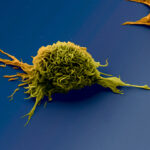Link to Pubmed [PMID] – 9973458
J Immunol 1999 Feb; 162(4): 1910-6
Among bacterial toxins, the adenylate cyclase toxin of Bordetella pertussis (CyaA) has a unique mechanism of entry that consists in the direct translocation of its catalytic domain across the plasma membrane of target cell, a mechanism supposed to be independent of any endocytic pathway. Here, we report that the CyaA toxin is delivered to the cytosolic pathway for MHC class I-restricted Ag presentation. Using peritoneal macrophages as APC, we show that the OVA 257-264 CD8+ epitope genetically inserted into a detoxified CyaA (CyaA-OVA E5) is presented to CD8+ T cells by a mechanism requiring 1) proteasome processing, 2) TAP, and 3) neosynthesis of MHC class I. We demonstrate that the presentation of CyaA-OVA E5, like the translocation of CyaA into eukaryotic cells, is dependent on extracellular Ca2+ and independent of vacuolar acidification. Moreover, inhibitors of the phagocytic and macropinocytic endocytic pathways do not affect the CyaA-OVA E5 presentation. The absence of specific cellular receptors for CyaA correlates with the ability of various APC to present the recombinant CyaA toxin, including dendritic cells, macrophages, splenocytes, and lymphoid tumoral lines. Taken together, our results show that the CyaA presentation pathway is not cell type specific and is unrelated to a defined type of endocytic mechanism. Thus, it represents a new and unconventional delivery of an exogenous Ag into the conventional cytosolic pathway.





